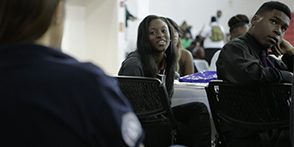Adriane Johnson-Williams, founding facilitator for the Seeding Success partnership in Memphis, Tenn., is exploring what it looks like to truly do the work of collaborative action. Through stories of challenging conversations and genuine relationship building, she shares her experiences working to change behaviors and practices in pursuit of better and more equitable outcomes at scale. A native Memphian committed to improving outcomes in her hometown, she now works in philanthropy.
When I joined Seeding Success in Memphis, Tenn., I was the third employee: the facilitator. I, a black woman, would be the person managing relationships with the most diverse group of people involved in the effort.
Memphis, Tenn., is a majority black city and our count-wide work focused on a majority black population. We had recently gone through a period of intense racial conflict around creating a county-wide school district. What had been two school districts — Memphis City and Shelby County — became one school district, and after months of legal battles, was fractured into seven districts. The conflict exposed an antipathy for black children and families living in poverty and a preference for racially and economically segregated schools that are core to the identity of this deeply southern city.
The Memphis context may be distinct, but the work of improving cradle-to-career outcomes is similar across the nation. We are often talking about racial and economic inequalities that overlap and, in my experience, these conversations tend to happen in rooms filled largely with white people leading collective impact efforts across the country.
Seeding Success’ work was, unsurprisingly, launched and led by a white man. Our continuous improvement director was a brilliant and outspoken white woman. Although we got along well, our team was at our core a team of rivals. The differences among the three of us could have ruined us, given our ideas and experiences regarding race, gender, culture and epistemology (our way of knowing), but they didn’t. What happened?
We had to acknowledge our differences and adapt.
As a member of the StriveTogether Cradle to Career Network, we learned from and critiqued the Theory of Action, a rational document that privileges empiricism. The Theory of Action lends itself well to having a white man stand in front of a room of mostly white male corporate leaders to convince them that action needs to be taken and to invest in that action. It lends itself well to having a woman stand in front of a diverse room of educational leaders to impress upon them the need to partner with people from other sectors. What the Theory of Action alone does not do, however, is lend itself well to a black woman, no matter how well she understands the data, to convince a group of mid-level managers or frontline staff of color that they have any role to play in interrupting what they see as a fundamentally white-controlled space.
In the U.S., white men and black women exist at polar opposites of every social and economic hierarchy. And a team with a male leader and female staff paints a gender portrait of hierarchy that is familiar and appealing, or painful, depending on the audience. On the surface, our team was a volatile mix, but we were committed to being open about that volatility. Because we were open, we were able to speak frankly about how we were replicating race and gender dynamics while also trying to challenge them.
I doubt we could have handled this challenge ourselves. Thanks to our participation in the StriveTogether Leadership Program in partnership with the Annie E. Casey Foundation, we were introduced to results-based leadership and the power of adaptive leadership. We were given permission to consider different ways of adapting our approaches to our various audiences. We were guided to interrogate our own team relationships and the role our identities played in our team dynamics. This informed how we could make progress in changing our local systems in the context of the realities of the lived experiences of community members.
The gift of our team was that we were able to play out potential conflicts in private before we stood before our various audiences. Our volatile mix was our strength. At the same time, our image was and is a hindrance in challenging the local norms. We are left with more questions than answers:
- What work must white male leaders do to interrupt structural racism in their communities while sitting firmly in their privilege as leaders of complex work?
- How do women of color avoid being pigeon-holed as the community-facing team members, the relational people, while taking advantage of their connectedness to their communities?
- How do white women navigate the race and gender landmines of history and context?
- What roles are men of color playing in collective impact work? How do their identities and roles overlap?
- In what ways do more complex combinations of identity play into this work?
The actual members of the Memphis team have changed, but the face of the team is essentially the same. As the work is embraced across the community, the challenges have become even greater as the appeal of the terms “collective impact,” “collaboration” and “outcomes” have hidden the complexity of the work. What our team members have learned about identity, leadership and equity is not easily translated. As rivals, the work becomes doing, being, teaching and learning all at the same time.
 Adriane Johnson-Williams, Ph.D. was the founding facilitator for Seeding Success, a StriveTogether Cradle to Career Network partnership in Memphis, Tenn. She now works in philanthropy. She is a native Memphian committed to improving outcomes in her hometown.
Adriane Johnson-Williams, Ph.D. was the founding facilitator for Seeding Success, a StriveTogether Cradle to Career Network partnership in Memphis, Tenn. She now works in philanthropy. She is a native Memphian committed to improving outcomes in her hometown.





